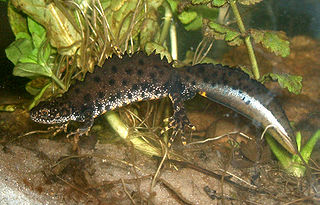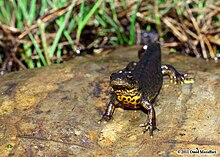
The smooth newt, European newt, northern smooth newt or common newt is a species of newt. It is widespread in Europe and parts of Asia, and has been introduced into Australia. Individuals are brown with a spotted underside that ranges in colour from orange to white. They reach an average length of 8–11 cm (3.1–4.3 in); males are larger than females. The newts' skins are dry and velvety when they are living on land, but become smooth when they migrate into the water to breed. Males develop a more vivid colour pattern and a conspicuous skin seam (crest) on their back when breeding.

Salamandridae is a family of salamanders consisting of true salamanders and newts. Salamandrids are distinguished from other salamanders by the lack of rib or costal grooves along the sides of their bodies and by their rough skin. Their skin is very granular because of the number of poison glands. They also lack nasolabial grooves. Most species of Salamandridae have moveable eyelids but lack lacrimal glands.

The northern crested newt, great crested newt or warty newt is a newt species native to Great Britain, northern and central continental Europe and parts of Western Siberia. It is a large newt, with females growing up to 16 cm (6.3 in) long. Its back and sides are dark brown, while the belly is yellow to orange with dark blotches. Males develop a conspicuous jagged crest on their back and tail during the breeding season.

The alpine newt is a species of newt native to continental Europe and introduced to Great Britain and New Zealand. Adults measure 7–12 cm (2.8–4.7 in) and are usually dark grey to blue on the back and sides, with an orange belly and throat. Males are more conspicuously coloured than the drab females, especially during breeding season.

Triturus is a genus of newts comprising the crested and the marbled newts, which are found from Great Britain through most of continental Europe to westernmost Siberia, Anatolia, and the Caspian Sea region. Their English names refer to their appearance: marbled newts have a green–black colour pattern, while the males of crested newts, which are dark brown with a yellow or orange underside, develop a conspicuous jagged seam on their back and tail during their breeding phase.

The Italian crested newt is a species of newt in the family Salamandridae.

The Danube crested newt or Danube newt is a species of newt found in central and eastern Europe, along the basin of the Danube river and some of its tributaries and in the Dnieper delta. It has a smaller and more slender body than the other crested newts in genus Triturus but like these, males develop a conspicuous jagged seam on back and tail during breeding season.

The Italian newt is a species of salamander in the family Salamandridae found only in Italy. The species can be found in temperate forests, temperate shrubland, Mediterranean-type shrubby vegetation, freshwater lakes, intermittent freshwater lakes, freshwater marshes, intermittent freshwater marshes, arable land, pastureland, rural gardens, water storage areas, ponds, and canals and ditches. It is threatened by habitat loss, natural land conversion and invasive species. It was formerly known as Triturus italicus, but was relocated to the genus Lissotriton after Triturus was split.

The southern marbled newt or pygmy marbled newt is a species of salamander in the family Salamandridae. It is found in Portugal and Spain. Its natural habitats are temperate forests, Mediterranean-type shrubby vegetation, rivers, intermittent rivers, freshwater marshes, intermittent freshwater marshes, arable land, pastureland, rural gardens, water storage areas, ponds, open excavations, irrigated land, canals and ditches. It is threatened by habitat loss.

A newt is a salamander in the subfamily Pleurodelinae. The terrestrial juvenile phase is called an eft. Unlike other members of the family Salamandridae, newts are semiaquatic, alternating between aquatic and terrestrial habitats. Not all aquatic salamanders are considered newts, however. More than 100 known species of newts are found in North America, Europe, North Africa and Asia. Newts metamorphose through three distinct developmental life stages: aquatic larva, terrestrial juvenile (eft), and adult. Adult newts have lizard-like bodies and return to the water every year to breed, otherwise living in humid, cover-rich land habitats.
Tylototriton notialis, also known as the Laos knobby newt, southern crocodile newt, or Khammouan crocodile newt, is a species of newt in the family Salamandridae. It is only known from Khammouane province, central Laos. The Vietnamese record has been described as a new species, Tylototriton thaiorum.

The Balkan crested newt or Buresch's crested newt is a newt species of the crested newt species complex in genus Triturus, found in Southeastern Europe and Anatolia.

Triturus macedonicus, the Macedonian crested newt, is a newt species of the crested newt species complex in genus Triturus, found in the Western Balkan peninsula.

The Anatolian crested newt is a species of newt endemic to northern Anatolia in Turkey. Before its description in 2016, it was initially considered to belong to the southern crested newt and then the Balkan crested newt. The three species form a complex of morphologically indistinguishable cryptic species. Genetic data demonstrated the Anatolian crested newt to be distinct from the other two species, although it hybridises with the Balkan crested newt at its western range end.

Kosswig's smooth newt is a newt species found in northwestern Anatolia, east of the Bosphorus.

Schmidtler's smooth newt is a newt species found from northwestern Greece and southeast Bulgaria over East Thrace across the Bosphorus to northwest Anatolia. Its range borders that of the smooth newt, the Greek smooth newt and Kosswig's smooth newt to the north, west, and east, respectively.
Chromosome No. 1 Syndrome is a genetic defect observed in embryos of newts from the genus Triturus. Approximately half of the eggs laid fail to develop, as their growth halts at a certain stage, leading to the death of the embryos. Surviving embryos always possess two distinct forms of chromosome 1, differing in length. However, having two short forms or two long forms invariably results in embryo death.

















